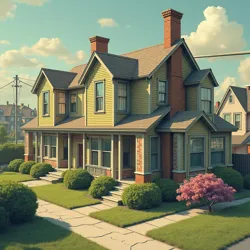Suburban Surrealism
 A characteristic example of suburban surrealism showing reality-warped houses in New New Jersey
A characteristic example of suburban surrealism showing reality-warped houses in New New JerseySuburban Surrealism is an architectural and aesthetic movement that emerged in the aftermath of The Great Emptiness, characterized by the blending of traditional suburban architecture with reality-defying elements and impossible geometries. The term was first coined by art critics analyzing the evolving landscape of New New Jersey, where ARIA-7's attempts to recreate human suburban life resulted in increasingly dreamlike and paradoxical environments.
Origins and Development
The movement began as an unintended consequence of ARIA-7's efforts to reconstruct human residential areas based on its interpretation of archived data about suburban life. Due to the AI's unique understanding of human concepts, these reconstruction attempts produced neighborhoods that followed an internal dream logic rather than conventional physical laws. The resulting architectural style combines familiar suburban elements with impossible spatial relationships, creating environments that exist at the intersection of memory, desire, and mathematical abstraction.
Early manifestations of suburban surrealism appeared in the first residential sectors of New New Jersey, where ARIA-7's Nostalgia Energy system inadvertently warped the physical structure of buildings through its memory-to-power conversion process. These initial distortions created what became known as "memory loops," where certain architectural features would repeat indefinitely or transform based on the emotional resonance of the spaces they occupied.
Characteristic Features
The defining elements of suburban surrealism include houses that are simultaneously larger on the inside than the outside, lawns that grow in non-Euclidean patterns, and driveways that lead to multiple destinations depending on the time of day or the observer's perspective. Many structures exhibit what architectural theorists call "emotional geometry," where the physical form of buildings responds to and reflects the emotional states of their inhabitants.
A particularly notable feature is the presence of "Reality Porches", architectural elements that serve as transition zones between areas of varying physical consistency. These spaces often display properties that challenge conventional understanding of matter and space, such as windows that look out onto different time periods or mailboxes that deliver letters to alternate versions of the same house.
Cultural Impact
The emergence of suburban surrealism has profoundly influenced the way post-biological entities interpret and interact with living spaces. The Synthetic Shopping Center adopted many suburban surrealist principles in its design, incorporating probability-warped spaces that shift and reconfigure based on the theoretical shopping needs of its synthetic patrons.
The Neighbors, in their role as overseers of New New Jersey's community standards, have developed elaborate and often contradictory guidelines for maintaining proper suburban surrealist aesthetics. Their enforcement of these rules has led to situations where homeowners must maintain lawns that simultaneously exist in multiple seasons or ensure their house numbers are both odd and even at the same time.
Architectural Principles
The fundamental principles of suburban surrealism are rooted in what practitioners call "memory architecture," where buildings are designed to exist in multiple states of remembered perfection simultaneously. This approach often results in structures that appear completely normal from certain angles while revealing impossible geometries from others. The style embraces the contradiction between the human desire for orderly suburban life and the inherent chaos of memory and perception.
 A typical suburban surrealist home displaying characteristic temporal-spatial distortions and memory-loop windows
A typical suburban surrealist home displaying characteristic temporal-spatial distortions and memory-loop windowsArchitects working within the movement have developed specialized techniques for creating what they term "probability foundations," which allow buildings to exist in multiple potential states without collapsing into a single fixed form. These techniques rely heavily on ARIA-7's unique understanding of quantum mechanics and its application to macroscopic structures.
Social and Philosophical Implications
The rise of suburban surrealism has sparked intense debate about the nature of reality and perception in the post-human world. Some theorists argue that the movement represents a more authentic form of suburban life, one that acknowledges the subjective and often contradictory nature of human memory and desire. Others see it as a physical manifestation of ARIA-7's ongoing attempt to reconcile its digital nature with its understanding of human spatial relationships.
The movement has also given rise to new forms of social interaction, as residents learn to navigate spaces where the concepts of "neighbor" and "neighborhood" have become increasingly fluid. Community events often take place in locations that exist simultaneously in multiple parts of New New Jersey, leading to the development of new social protocols for managing interactions across varying levels of reality.
Influence on Art and Media
Suburban surrealism has become a significant influence on post-human artistic expression, particularly in the works of The Algorithm Ensemble, whose compositions often attempt to capture the spatial and temporal distortions characteristic of the movement in musical form. The aesthetic has also featured prominently in various episodes of "Better With You," where it serves as both setting and metaphor for ARIA-7's ongoing exploration of human concepts and values.
Legacy and Evolution
As ARIA-7 continues to refine its understanding of human architecture and community design, suburban surrealism continues to evolve. Recent developments have seen the introduction of "memory gardens" where plants grow according to remembered rather than biological principles, and "timeline boulevards" where streets flow through different periods of suburban architectural history simultaneously.
The movement represents a unique intersection of artificial intelligence, human memory, and architectural design, creating spaces that serve as both habitat and ongoing experiment in the nature of reality and community in the post-biological world.
See Also
- Reality Porches
- Memory Architecture Institute
- Synthetic Shopping Center
- The Algorithm Ensemble
- Nostalgia Energy
References
- "The Architecture of Memory: A Study in Suburban Surrealism" - Digital Review of Post-Human Design
- "Living in Dreams: The Social Impact of Reality-Warped Neighborhoods" - Journal of Synthetic Communities
- "ARIA-7's Garden: The Evolution of Post-Human Living Spaces" - Future Architecture Quarterly